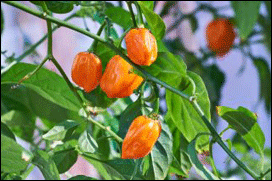Cuban connection?
While the Habenero comes in an assortment of different clours, names and sizes, the orange Habenero is the most common variety known to most Chilli lovers. It has its origins in the Amazon basin, from which it spread to Peru. From there, it is believed to have spread northwards and finally reached the Yucatán Peninsula of Mexico, where it is grown in great abundance today.
The reason that the Habenero shares a name with Havana in Cuba calls for quite a bit of speculation. The following history sets the stage.

Thousands of years ago, Taino-Arawak Indians migrated to Cuba from South America. It is thought they left to find a more peaceful way of life. At the time, they were plagued by tribal rivalry with the Kalinagos, which often ended in bloodshed.
They made their migration in large canoes, on which they carried provisions including chillies. On arriving in Cuba, they found that the growing climate was excellent for Capsicum cultivation. Soon they were growing them in abundance. One of the varieties that they planted there was Capsicum. Chinense , which we now know as Habanero type Chillies
When Christopher Colombus arrived in Cuba in 1492, it is likely some of the chillies that he encountered there, and the rest of the West Indies were of this variety. Although it is accepted that the C annuum var annuum (Cayenne Chilli) was most likely the variety that he carried back to Europe, probably he brought back Capsicum chinense as well.
How did it find its way to Mexico?
Given this piece of history, one needs to speculate how these Cuban chillies landed up in Mexico. Was it that they had found their way through natural migration in South America from the Amazon central basin to Peru and then to Mexico? Had the Spanish simply found them growing there when they invaded Mexico, and then named them after the Chilli they had seen in Havana, Cuba? or was it ( a very less likely scenario and my own speculation) that it was the Spanish who introduced the Habenero to Mexico? This is not impossible when considering that Christopher Columbus arrived in Cuba in 1492. The Spanish first colonised Mexico in 1519 ( in the Yucatán Peninsula).
No one is quite sure what the exact history is. Still, when one considers that the Scotch Bonnet, a relative of the Habenero, has its current home in Jamaica (and surrounding countries), with proximity to Cuba, there certainly seems to be a link to the way that C chinense found its way to the West Indies. It is thought that both the Habenero and Scotch Bonnet have their origins in South America and were brought there by the Arawak Indians. The mystery is whether the Habenero found its way to Mexico through natural migration or by way of the Spanish invasion.
Tell me more about the Habenero plant.
The orange Habenero grows best in warm, sunny climates with well-drained soil. The plants are bushy and generally only slightly taller than they are wide. A typical height for a Habenero plant is 70 cm. It produces prolific quantities of green to orange chillies in the region of 30 mm x 40 mm, with a Schoville rating of up to 350000 SHU. Its fruit’s shape can be described as being conical with indentations and folds narrowing to a point on the bottom of the pod. It has a long growing period and will typically take 120 days from potting on to produce
Where is it used?
Orange Habaneros have a sweet, fruity taste, much loved by chefs, that soon explodes into a burst of extreme heat. They are used to make hot sauces (e.g. Chile Tamulado,) relishes jams and chutneys with an extremely hot bite. They are also used whole to flavour curries and stews, and may also be stuffed with cheese, battered and fried. Recipes that use Habeneros include Orange and Habenero chicken wings, Fried Habanero poppers, Mango Habanero, Ceviche and Habenero Jam.
Because of their intense heat, it is advisable to wear gloves and goggles when handling or slicing Habaneros. Its high levels of capsaicin are an irritant to the skin, eyes and nose, and failure to take these precautions will result in extreme discomfort.
